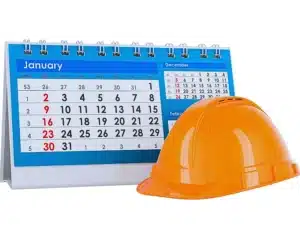As of April 29, 2025, Nevada OSHA is now enforcing a new heat illness prevention rule, Regulation R131-24AP. These protections aim to reduce heat-related injuries and deaths across industries where high temperatures are a daily threat.
Nevada summers aren’t just uncomfortable. They’re dangerous, especially for those working outside or in non-air-conditioned environments. After a record-breaking summer in 2024, where Las Vegas temperatures climbed to 120 °F, state regulators took action.
For workers and employers alike, understanding the new rule isn’t optional, it’s the law. If you’ve been affected by unsafe working conditions in extreme heat, the team at George Bochanis Injury Law Offices in Las Vegas can help. Call 702-388-2005 to learn more about your rights and legal options.
Why Nevada Stepped In
The numbers told a clear story. Between 2021 and 2024, heat-related workplace complaints in Nevada rose from 344 to 467. Meanwhile, employers across sectors, including construction, landscaping, hospitality, warehousing, struggled to balance productivity with worker safety.
Nevada previously relied on federal OSHA guidelines, which lacked enforcement teeth. However, the new rule gives Nevada OSHA the authority to hold employers accountable and protect workers before injuries occur.
Who Is Covered by the New Regulation?
The rule applies to most Nevada employers with 10 or more employees working outdoors or in indoor spaces without climate control. This includes industries like roadwork, roofing, delivery services, kitchens, and factory work.
Some settings are exempt. Workers in fully climate-controlled indoor environments or in vehicles with functioning air conditioning are not covered, unless the cooling system fails. In those cases, employers must provide alternative protections until the issue is fixed.
Employer Responsibilities Under the New Rule
Nevada’s new OSHA heat regulation provides guidelines employers must follow to prevent heat-related illness and injury in the workplace. These responsibilities include assessing risk, planning ahead, educating workers, and responding effectively to emergencies.
Written Job Hazard Analysis (JHA)
One of the central requirements of the new rule is the Job Hazard Analysis. Employers must complete a one-time written assessment for each job classification where workers are exposed to heat for 30 minutes or more in any hour.
This analysis must account for temperature, humidity, radiant and conductive heat sources, physical workload, and any personal protective equipment used. If conditions change or a heat-related incident occurs, such as a worker suffering heat stroke in Las Vegas, the JHA must be updated.
Heat Illness Prevention Plan (HIIP)
If the JHA identifies any risk of heat illness, the employer must create and implement a written Heat Illness Prevention Plan. This plan must include:
- Access to potable drinking water
- Provisions for rest and recovery breaks
- Cooling methods, such as shade, fans, or air-conditioned break areas
- A designated monitor to assess risk and initiate emergency response
- Mitigation steps for heat-generating processes or machinery
- A clearly outlined emergency medical response plan
This plan should be reviewed regularly and updated as necessary to reflect changes in job tasks, conditions, or personnel.
Employee Training
Before being assigned to heat-exposed tasks, workers must be trained to recognize symptoms of heat illness and understand how to respond. The training must cover prevention techniques, early warning signs, reporting procedures, and emergency protocols.
Training should also include how to properly hydrate, pace physical exertion, and use protective equipment provided.
Active Monitoring and Emergency Response
Employers must designate someone to actively monitor conditions during heat exposure and take action if a worker shows signs of illness. This monitor must have the authority to stop work, call emergency services, and ensure the affected worker receives prompt medical attention.
Additionally, employers are expected to develop and communicate a clear emergency response procedure, including access to first aid, transportation, and emergency contacts.
The Designated Monitor: A Key Role in Worker Safety
Under the new rule, every worksite must have a designated person, and a backup, who monitors conditions and acts when a worker shows signs of heat distress. This person must be able to contact emergency services, ensure safe transportation, and communicate the nature of the injury to medical providers.
What This Means for Workers
With these new protections, workers have clearer rights to safe working conditions during heat exposure. Employers must provide water, rest, and a way to cool down. Workers are also entitled to training and quick action if they experience heat illness symptoms such as cramps, dizziness, headache, confusion, or fainting.
Even if you work in a setting that is usually climate-controlled, such as a warehouse or delivery truck, you may still be protected if the air conditioning fails. Temporary safety measures must be put in place until normal conditions are restored.
When Heat Illness Leads to a Workers’ Comp Claim
Heat-related injuries are covered under Nevada’s workers’ compensation system. If you suffer from heat exhaustion, heat stroke, or another related condition due to your job, you have the right to file a claim.
Workers’ comp can help cover medical treatment, partial wage replacement, and rehabilitation costs. Employers must document incidents and cannot retaliate against employees who file a claim in good faith.
Injured by Workplace Heat? Learn Your Legal Options Under Nevada OSHA
The new Nevada OSHA heat illness rule represents a major shift in how heat safety is regulated across the state. With triple-digit temperatures becoming the norm in Las Vegas and other parts of Nevada, these standards are not just overdue, they’re essential.
If you’ve suffered a heat-related injury at work or believe your employer is ignoring safety requirements, it may be time to speak with an attorney. Workers in Nevada are entitled to protections, medical care, and compensation when heat exposure leads to harm. At George Bochanis Injury Law Offices, we help injured workers in Las Vegas understand their rights and take action when employers fail to follow the law.
Contact our team at 702-388-2005 to discuss your situation. We’ll help you determine whether you have a workers’ compensation claim or grounds for further legal action.





